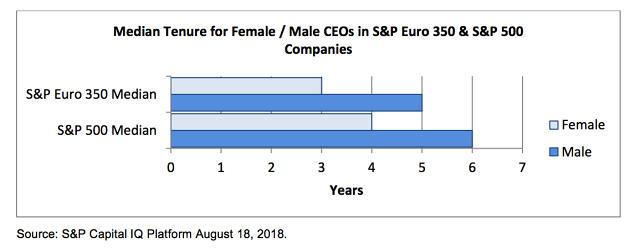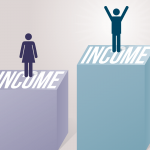The CEO Gender Gap Is Slowly Closing At Major Public Companies
Progress is being made in closing the gender gap for the top jobs in the S&P 500, albeit very slowly.
There are now 27 female CEOs in the index, according to the latest S&P Capital IQ. That’s up from 21 in 2015. The S&P 500 can now profess a 5.4% share of female CEOs, up from 4.2% last year.
The annual report analyzed leadership among S&P 500 companies every year starting in 2006. When multiple CEOs lead a company, the longest serving one is counted. Where there is no acting CEO, researchers use the highest-ranking board member as a proxy. The study provides a longitudinal view of CEO trends by analyzing the 500 companies that represent approximately 80% of available market capitalization when combined.
There’s a business case for having more women in the C-suite. Studies have shown that companies with more women in management deliver 34% greater returns to shareholders. Although female CEOs led only 5% of Fortune 1000 companies, they generated 7% of the group’s total revenue and outperform the S&P 500 index during the course of their respective tenures.
Unfortunately, however, those tenures tend to be much shorter than those of their male counterparts, according to the S&P Capital IQ. While men serve an average of over six years, female CEOs average only four.
“While four to six years is not largely significant,” writes Pavle Sabic, the director of market development of the S&P Capital IQ and author of the study, “in the context of a lifelong career, it may translate to a significant economic opportunity cost to women.”

The discrepancy in tenure length may be in part due to the fact that once in the top, job female CEOs are more likely to be targeted by shareholder activism.
There are a number of sectors that lead the way in female representation, and they’re not necessarily the ones traditionally associated with gender equality. Those with the most female CEOs included information technology, utilities, and consumer discretionary, with five in each sector, followed by financials and consumer staples, with four.
“In a surprising and positive development since our previous report in March 2016, we are seeing increased momentum in closing the gender gap at blue chip companies across multiple sectors,” wrote Sabic.

In spite of the progress that is being made, however, the number of S&P 500 companies with female CEOs only grew by an average rate of 1.1 each year since 2009, according to S&P Capital IQ.
The materials and telecoms sectors remain without a single female representative among its S&P 500 CEOs. At this rate, the Institute for Women’s Policy Research predicts it will take until 2056 to reach gender parity.
“During a time when companies are under increasing pressure to diversify the demographics of their employee base, especially to increase the number of females at the helm, we have not seen the statistics change dramatically,” wrote Sabic, adding, “however, progress is being made.”
Fast Company , Read Full Story
(24)












